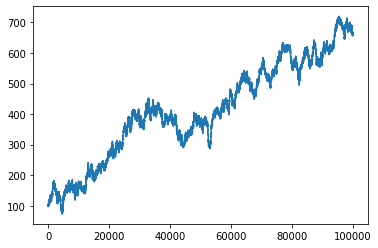Example 5.4#
Simulation of a continuous-space Markov chain.
import numpy as np
import matplotlib.pyplot as plt
rng = np.random.default_rng(15)
# Note our system x_n = a x_{n-1} + noise
T = 1000
x = np.zeros(T)
x[0] = 100
a = 0.9
for t in range(1,T):
x[t] = a * x[t-1] + rng.normal(0,1)
plt.plot(x)
plt.show()

We can see that the chain starts from \(x_0 = 100\) but converges to its stationary measure. For some values \(a\), this may not hold. See the example below with \(a = 1\).
import numpy as np
import matplotlib.pyplot as plt
rng = np.random.default_rng(15)
# Note our system x_n = a x_{n-1} + noise
T = 100000
x = np.zeros(T)
x[0] = 100
a = 1
for t in range(1,T):
x[t] = a * x[t-1] + rng.normal(0,1)
plt.plot(x)
plt.show()

This chain will not converge anywhere.
